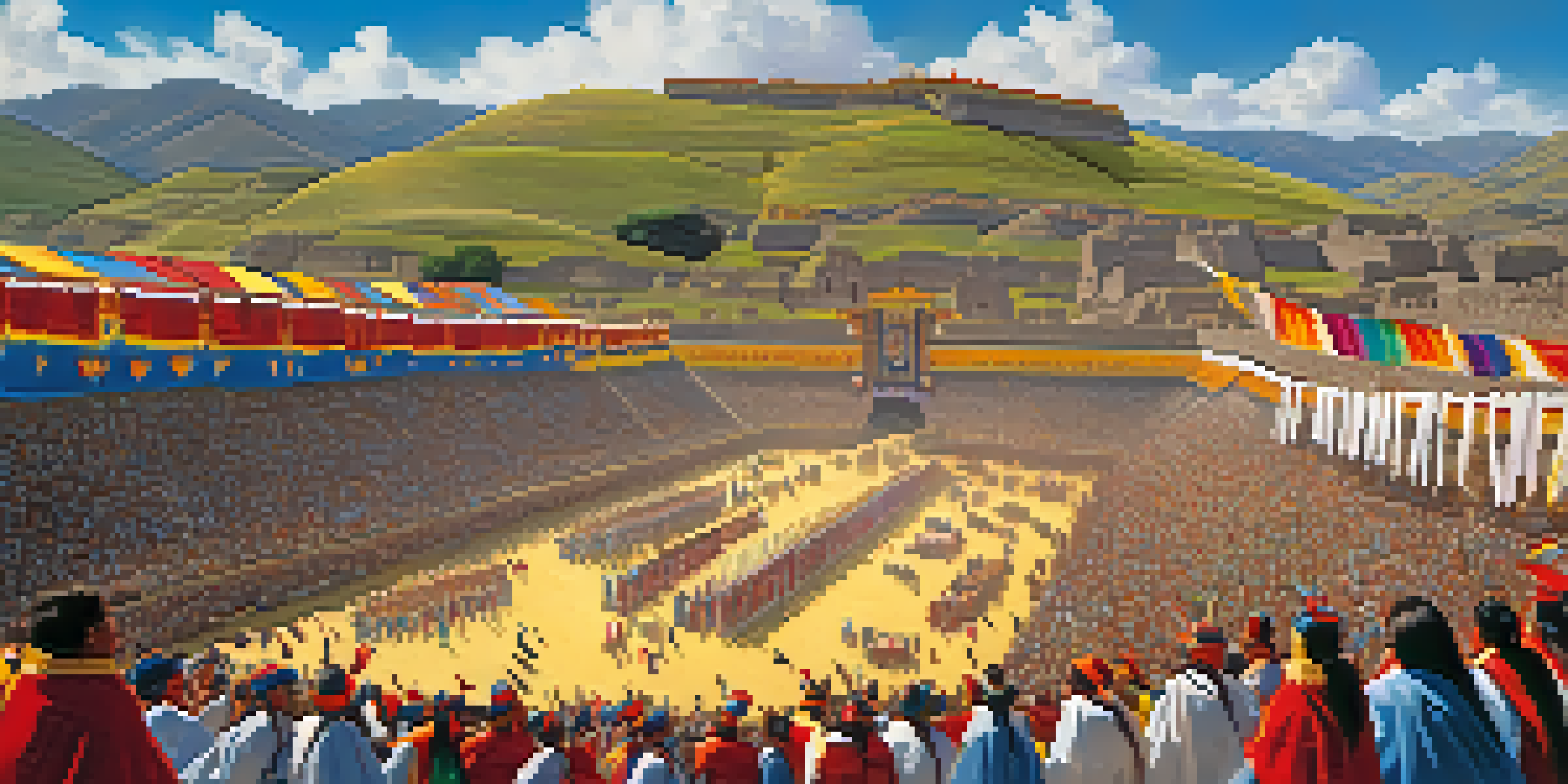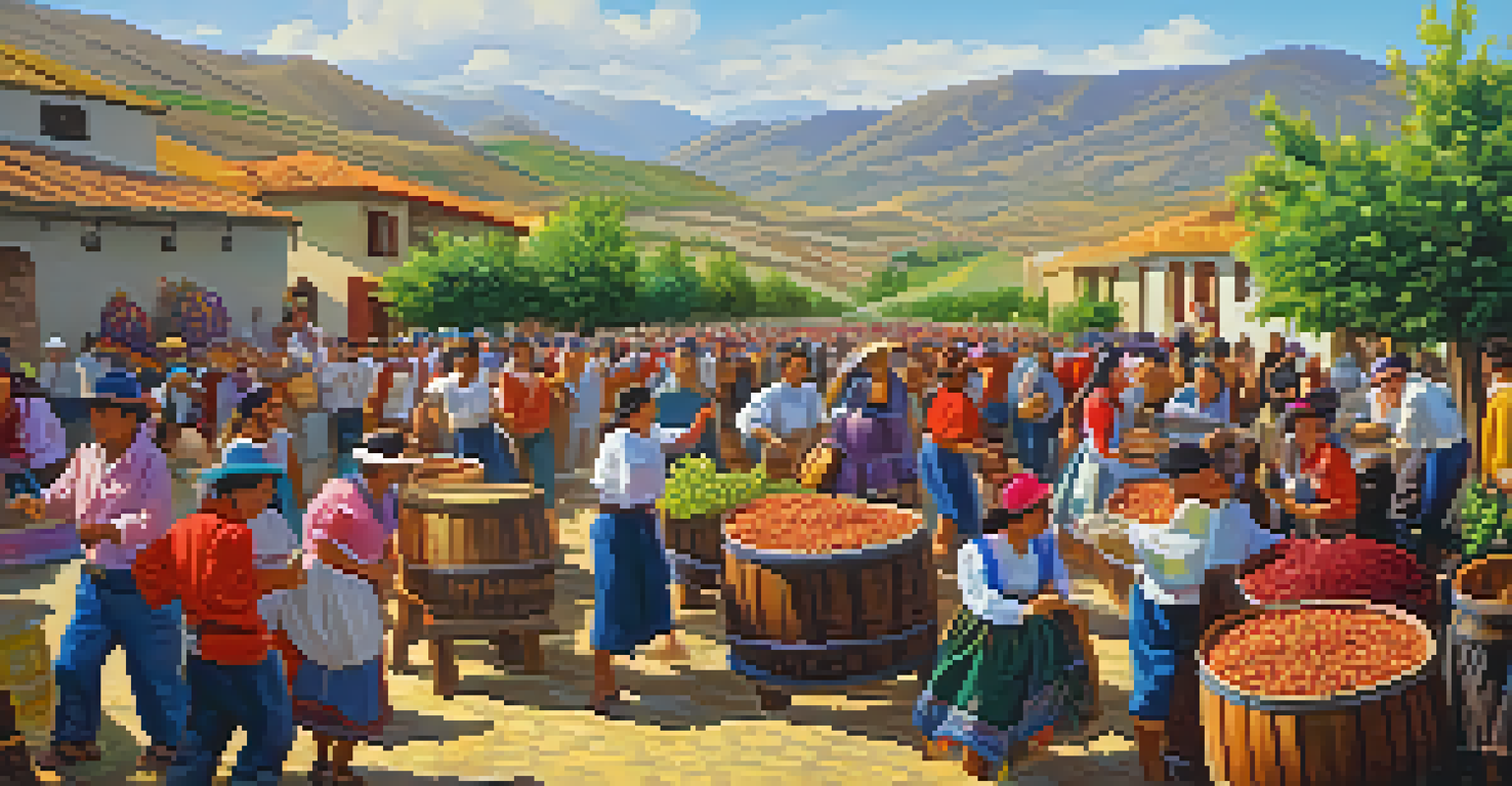An Overview of Peru's Unique Harvest Festivals and Traditions

An Introduction to Peru's Rich Harvest Festival Culture
Peru is renowned for its vibrant culture, and its harvest festivals are a testament to this colorful heritage. These events reflect the agricultural richness of the land and the deep-rooted traditions of its people. From the Andes to the Amazon, each region boasts unique celebrations that honor the earth's bounty.
The earth has music for those who listen.
Harvest festivals in Peru often coincide with the agricultural calendar, celebrating the completion of a successful crop cycle. These events are not just about the food; they encompass music, dance, and spiritual rituals that connect communities. It's a time for gratitude, reflection, and communal joy.
As you dive into the various festivals, you'll discover how they highlight the unique customs of each region, showcasing the diversity of Peru's cultural landscape. Each festival tells a story, inviting both locals and visitors to participate in the rich tapestry of Peruvian life.
Inti Raymi: The Festival of the Sun
One of the most famous harvest festivals in Peru is Inti Raymi, celebrated in Cusco every June. This ancient Incan festival honors Inti, the sun god, and marks the winter solstice. The event is a grand spectacle, featuring colorful parades, traditional music, and reenactments of Incan rituals.

During Inti Raymi, thousands gather at the Sacsayhuamán ruins to witness the vibrant performances that bring history to life. Participants dress in elaborate costumes, and the atmosphere is filled with excitement and reverence. This celebration not only honors the sun but also serves as a reminder of the Incan civilization's deep connection to agriculture.
Celebrating Peru's Agricultural Richness
Peru's harvest festivals highlight the country's diverse agricultural practices and cultural heritage.
The festival culminates in a ceremonial offering to the sun, where the people express gratitude for the harvest and ask for a fruitful year ahead. Inti Raymi is a beautiful blend of history, spirituality, and community, showcasing the enduring legacy of Peruvian culture.
La Fiesta de la Vendimia: A Grape Harvest Celebration
La Fiesta de la Vendimia, or the Grape Harvest Festival, takes place in the Ica region, renowned for its vineyards. Celebrated in March, this festival marks the end of the grape harvest season, and it's an occasion filled with joy and celebration. The event features wine tastings, parades, and contests, making it a lively experience for all attendees.
Tradition is not the worship of ashes, but the preservation of fire.
During the festival, locals showcase their winemaking skills, and visitors can sample some of the best wines and pisco, a traditional Peruvian spirit. The festivities often include live music, dance performances, and even grape stomping, where participants crush grapes with their feet, adding a playful element to the celebration.
La Fiesta de la Vendimia is not just about the grapes; it’s also a celebration of community, where families and friends come together to share in the festivities. This event highlights the importance of agriculture in Peru and the pride locals take in their harvests.
The Andean Potato Festival: Celebrating Diversity
The Andean Potato Festival, held in the highland regions of Peru, is a unique celebration dedicated to one of the country's staple crops. This festival honors the incredible diversity of potatoes found in the Andes, with over 3,000 varieties grown across the region. Held in May, it attracts locals and tourists eager to learn about this vital crop.
At the festival, visitors can sample various potato dishes, participate in cooking competitions, and enjoy traditional music and dances. The event also includes educational activities that highlight the nutritional value of potatoes and their significance in Andean culture. It's a fantastic way to appreciate the agricultural heritage of the region.
Community and Tradition Unite
These festivals foster a sense of belonging and pride among locals while inviting visitors to experience Peruvian culture.
The Andean Potato Festival fosters a sense of community and pride among local farmers, showcasing their dedication to preserving this important crop. It's a joyful celebration that underscores the cultural importance of potatoes in Peruvian cuisine and daily life.
El Señor de los Milagros: A Spiritual Harvest Tradition
El Señor de los Milagros, or the Lord of Miracles, is a deeply spiritual festival celebrated in October, particularly in Lima. While not exclusively a harvest festival, it intertwines agriculture with faith as communities come together to honor the miraculous black Christ statue. The festival draws thousands of devotees who participate in processions, prayers, and offerings.
During this time, many locals prepare traditional dishes using seasonal ingredients, reflecting their gratitude for the harvest. The event is marked by vibrant processions, where participants carry the statue through the streets, adorned with flowers and accompanied by music and dance. It's a powerful display of faith and community spirit.
El Señor de los Milagros reminds us of the connection between spirituality and agriculture in Peruvian culture. It emphasizes gratitude for the harvest and the importance of community support, making it a poignant celebration for many.
The Festivity of San Juan: Celebrating the Amazon
In June, the Festivity of San Juan celebrates the rich cultural heritage of the Amazon region. This festival honors Saint John the Baptist and is marked by traditional music, dance, and food, particularly dishes made with local ingredients like fish and fruits. It's a vibrant celebration that showcases the unique traditions of Amazonian communities.
One of the highlights of the festival is the preparation of juanes, a traditional dish made with rice, meat, and spices wrapped in bijao leaves. This culinary delight is a symbol of the festival and brings people together to share in the experience. The event also features colorful parades and cultural performances that reflect the spirit of the Amazon.
Spirituality in Harvest Celebrations
Many festivals intertwine spiritual beliefs with agricultural traditions, emphasizing gratitude and community support.
The Festivity of San Juan is a time for reflection, gratitude, and celebration of nature's abundance. It emphasizes the importance of community ties and the preservation of cultural traditions, making it a significant event for the people of the Amazon.
Chincha's Afro-Peruvian Harvest Festival
Chincha, a region known for its Afro-Peruvian culture, hosts a vibrant harvest festival that showcases the unique contributions of Afro-Peruvians to the country's agricultural practices. This festival is a celebration of music, dance, and culinary traditions that have been passed down through generations. Held in January, it brings together locals and visitors to honor the region's rich heritage.
Participants can enjoy live performances of traditional Afro-Peruvian music and dance, such as the festejo and zapateo. These art forms are not only entertaining but also tell the story of the Afro-Peruvian experience and their connection to the land. The festival also features a variety of local foods, highlighting the agricultural bounty of the region.

Chincha's Afro-Peruvian Harvest Festival is an essential reminder of the diverse cultural influences that shape Peru's identity. It fosters community pride and encourages visitors to appreciate the rich agricultural traditions that continue to thrive in the region.
Conclusion: The Significance of Peru's Harvest Festivals
Peru's harvest festivals are more than just celebrations; they are a reflection of the country's diverse cultures and agricultural practices. Each festival tells a unique story, connecting communities and honoring the natural bounty of the land. From the mountains to the coast, these events foster a sense of belonging and pride among locals.
Participating in these festivals offers a glimpse into the heart of Peruvian culture, where traditions are cherished and passed down through generations. They serve as a reminder of the importance of community, spirituality, and gratitude in daily life. For visitors, these festivals provide an enriching cultural experience that goes beyond mere tourism.
In essence, Peru's harvest festivals encapsulate the spirit of a nation that values its roots and celebrates its agricultural heritage. They are not only a feast for the senses but also a profound reflection of the interconnectedness of people, land, and tradition.